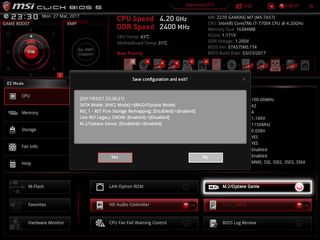MSI, Gigabyte Update BIOSes With Intel Optane Support

MSI and Gigabyte released new BIOSes for their 200-series motherboards to support Intel's Optane memory technology.
Optane is restricted to Intel 7th generation (Kaby Lake) processors and 200-series motherboards. Intel said the tech is supposed to give you a 28% overall system performance boost while also increasing hard drive access and "everyday task responsiveness" speeds by 14x and 2x, respectively. All you need is a compatible processor, motherboard, and Optane Memory product, like the 16GB and 32GB modules that were announced in late March.
The promise is that Optane will marry HDD capacities with SSD performance. The reality is a little bit less clear. Optane is much like Intel's Smart Response Technology introduced in 2011, and right now Optane Memory products act as I/O caches for their connected HDDs and SATA SSDs. That could help you if you're working primarily with relatively few applications or small amounts of data, but it could lead to problems for "prosumers" and professionals who use a variety of apps and larger datasets. As we explained when Intel announced the Optane Memory modules:
Cache technology brings a set of inherit risks. Stacking cache on top of cache amplifies the penalty of a cache miss. As an analogy: In baseball, you may go through several batters to get a hit. That takes time, and you could end up on the losing side of performance when an I/O request first strikes out the Optane cache, then the SLC layer cache, and finally has to reach out to the third layer. In this case, it's the TLC. The third batter gets a hit, but there are already two strikeouts on the scoreboard for the inning. Holding more data in the high-speed tier one cache helps to increase your chances of a hit. The more applications you use, the wider the strike zone becomes. Your core, daily use software is ready to swing for the fences, but the application you haven't run in six months has to be flown in from the Triple-A league. If your primary media is a hard disk drive, then you see a massive 20ms delay after swinging at fast balls for most of the day.
Still, these BIOS updates from MSI and Gigabyte will at least give you the option of using Optane if you want. The functionality was built into the companies' 200-series motherboards; it's merely a matter of unlocking it with these updates. MSI also includes an Optane Genie that "enables the use of Optane memory with just 1-click" instead of requiring "several challenging steps to successfully configure and enable Optane memory boosting."
You can find a list of MSI 200-series motherboards and their new BIOS versions in MSI's announcement. If you have a Gigabyte or "Aorus" 200-series motherboard, you can find the latest BIOS information on the board's product page. And if you want to learn more about Intel's 3D XPoint, which is at the heart of Optane, you can check out our guide to the technology's history, performance, competition, and more.
Stay on the Cutting Edge
Join the experts who read Tom's Hardware for the inside track on enthusiast PC tech news — and have for over 25 years. We'll send breaking news and in-depth reviews of CPUs, GPUs, AI, maker hardware and more straight to your inbox.

Nathaniel Mott is a freelance news and features writer for Tom's Hardware US, covering breaking news, security, and the silliest aspects of the tech industry.
-
ohim you pay the price of an SSD for a cache drive that helps you when you don`t have an SSD in your PC, and that`s only when the PC gets to cache w/e you try to do ... ... i really really don`t understand the use of this thing ...Reply -
derekullo That is correct on the first launch of the program.Reply
On the second launch of the program all data that was used to launch the program are stored in the optane cache and are loaded from there instead of the hard drive.
The problem is when the amount of data you cache exceeds the capacity of the optane cache, in which case the oldest data is erased and new data is written over it causing any programs that needed to use that old data to instead have to use the hard drive again. -
Petaflox I have a 250 gb ssd as primary HD and a 4 Tb secondary HD, I will gladly sacrifice 100Reply
gb on primary ssd as a cache to secondary HD, the only thing I need is a software can do that, Intel solution is expensive and easy to bypass. -
derekullo Intel Smart Response will do what you need, Petaflox, although it is limited to 64 gigabytes of ssd cache.Reply
NAS4FREE or FREENAS will also do what you need.
You build a computer yourself and load the NAS4FREE or FREENAS OS from a flash drive and it turns any computer into a NAS.
The best part is, is that it is able to use its own ram to cache read and write data, easily capping out gigabit or even 10 gigabit at a queue depth of 1, assuming you have enough ram, this is known as the, ARC cache (for reads).
Gamers don't really need a zil (write cache) due to games not being that heavy on writes.
Buy as much ram as you can to maximize the amount of data able to be cached to the ARC cache.
Of course, once you hit 32 gigabytes and 64 gigabytes of ram you start hitting a wall with most consumer motherboards.
There is another cache called the L2ARC or layer 2 arc which is an extension of the arc cache.
This is where you put your solid state drive if all of your data wont fit in the arc cache.
A 1 terabyte Samsung 850 Pro would work just fine as well as a 1 Terabyte Samsung 960 Pro M.2
I use NAS4FREE at home as both a backup server and ftp server.
I also ran a few tests with my steam library
My games load from my steam library over gigabit nearly as fast as from my Samsung 840 evo.
Of course the next step is to convert my house to 10 gigabit to really unlock the speed. -
Petaflox Reply19517003 said:Intel Smart Response will do what you need, Petaflox, although it is limited to 64 gigabytes of ssd cache.
NAS4FREE or FREENAS will also do what you need.
You build a computer yourself and load the NAS4FREE or FREENAS OS from a flash drive and it turns any computer into a NAS.
The best part is, is that it is able to use its own ram to cache read and write data, easily capping out gigabit or even 10 gigabit at a queue depth of 1, assuming you have enough ram, this is known as the, ARC cache (for reads).
Gamers don't really need a zil (write cache) due to games not being that heavy on writes.
Buy as much ram as you can to maximize the amount of data able to be cached to the ARC cache.
Of course, once you hit 32 gigabytes and 64 gigabytes of ram you start hitting a wall with most consumer motherboards.
There is another cache called the L2ARC or layer 2 arc which is an extension of the arc cache.
This is where you put your solid state drive if all of your data wont fit in the arc cache.
A 1 terabyte Samsung 850 Pro would work just fine as well as a 1 Terabyte Samsung 960 Pro M.2
I use NAS4FREE at home as both a backup server and ftp server.
I also ran a few tests with my steam library
My games load from my steam library over gigabit nearly as fast as from my Samsung 840 evo.
Of course the next step is to convert my house to 10 gigabit to really unlock the speed.
Most Popular






